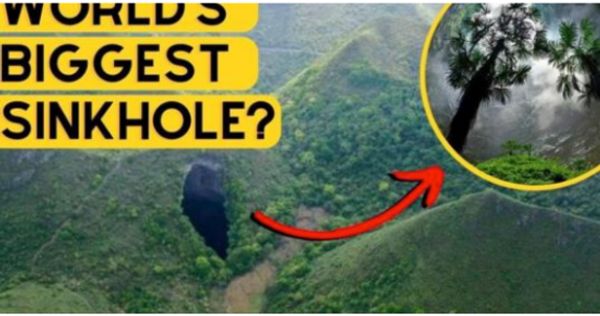
In China’s Leye-Fengshan Global Geopark, scientists have made an incredible discovery – a massive ancient forest located 630 feet below the surface of a sinkhole. Known as “Heavenly Pits”, this sinkhole is part of a region that is rich in natural wonders, including the world’s longest natural bridge and caves.
This stunning sinkhole is found in the Guangxi Zhuang Autonomous Region of China and has an intriguing geological history. The area is primarily made up of sedimentary rocks, with more than 60% of its rock composition being Devonian to Permian carbonate rocks. These sedimentary formations have formed an ‘S’-shaped structure and a rhombus configuration that give rise to two large subterranean rivers, namely the Bailang and Poyue. These rivers have shaped the surrounding karst terrain, resulting in the formation of karst geosites such as high karst peak clusters, poljes, natural bridges, extensive caves, and massive cave chambers. The area also boasts fault zones, minor folds, and even rare giant panda fossils.
Sinkholes are a common feature in karst landscapes like this one. They are formed when the loose soil structure erodes, either from above or below the surface, creating voids that can cause the land above to collapse. The newly discovered sinkhole in Leye-Fengshan Global Geopark is an impressive 630 feet deep, 490 feet wide, and over 1,000 feet long. Within this enormous space, scientists have found three cave openings, which may harbor new and undocumented plant and animal species.
Chen Lixin, the leader of the expedition, expressed excitement that they may discover new species in these underground caves. He noted that there were trees in the sinkhole that towered over 130 feet in height. George Veni, the director of the National Cave and Karst Research Institute, also commented on the unique karst landscape of southern China, which is home to numerous caves and sinkholes. He explained how slightly acidic rainwater contributes to the erosion of the rocks, eventually creating these remarkable underground formations.
The “Heavenly Pits” sinkhole is the thirty-first known opening in the region, showcasing the outstanding geology of China’s karst landscapes. Another notable sinkhole in the area, Xiaozhai Tiankeng, holds the title as the largest pit in the world.
The discovery of the sinkhole reveals yet another hidden wonder of our planet. China’s rich karst landscape continues to captivate scientists and nature enthusiasts alike, providing new insights and opportunities for exploration. To witness the breathtaking beauty of this sinkhole and learn more about its fascinating features, check out the video below:



